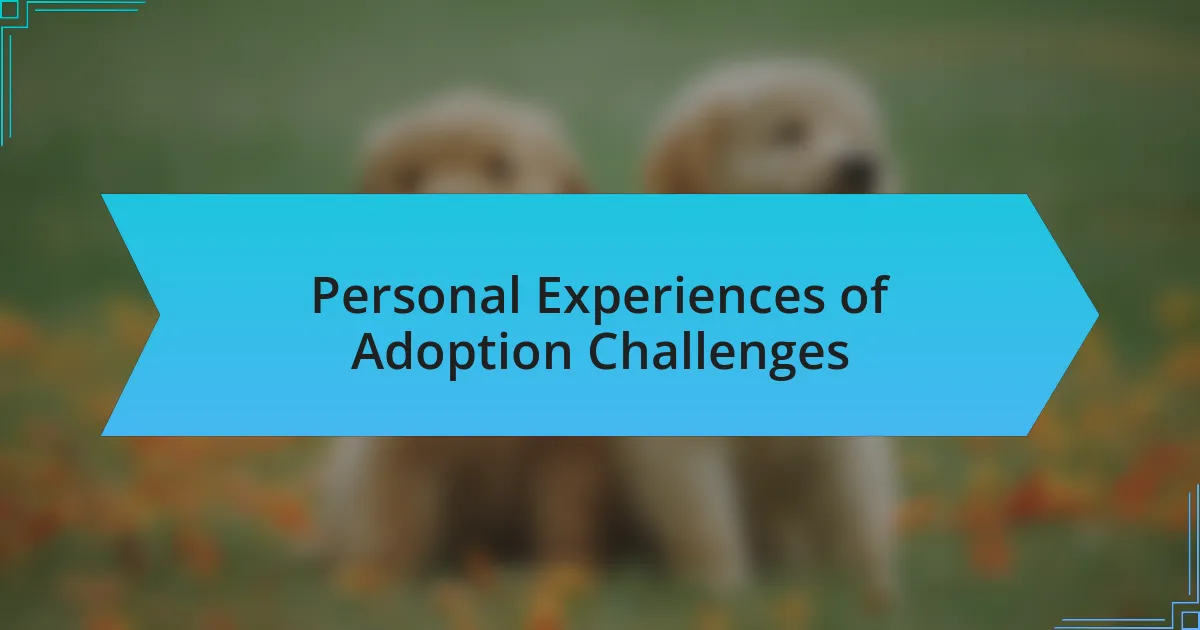Key takeaways:
- The animal adoption process involves selecting a pet, completing an application, and often undergoing a home visit to ensure a good match for both pet and owner.
- Animal Protection Societies advocate for animal welfare, educate the public on responsible pet ownership, and work towards legislative changes.
- Common misconceptions about adopting include the belief that shelter pets have behavioral issues and that adopting lacks rewards compared to purchasing a purebred.
- Evaluating personal readiness for adoption includes assessing lifestyle, emotional capacity, living situation, and financial stability before bringing a pet home.

Understanding Animal Adoption Process
The animal adoption process often begins with a visit to your local shelter or rescue organization. When I first walked into my local shelter, I was overwhelmed by the sheer number of pets eagerly waiting for a home. It made me wonder, how can I choose just one? It’s important to remember that adoption is not just about picking a pet; it’s about finding a companion that fits your lifestyle and emotional needs.
After selecting a potential furry friend, a thorough application and interview process usually follows. I vividly recall filling out a questionnaire about my living situation, work schedule, and what I envisioned for my new pet’s life. It felt like a relationship quiz, forcing me to truly consider the responsibilities of pet ownership. Why is this step so critical? Because it helps shelters ensure that animals are placed in homes where they will be loved, cared for, and properly supported.
Finally, many organizations require a home visit or a meet-and-greet before finalizing any adoption. This can initially feel intrusive, but I found it reassuring—knowing that the shelter genuinely cares about the well-being of their animals. Have you ever thought about how a new pet will adapt to your home? It’s a vital consideration that makes the adoption process more than just a formality; it’s a commitment to creating a safe and nurturing environment for your new best friend.

Importance of Animal Protection Societies
Animal Protection Societies play a crucial role in advocating for the welfare of animals in our communities. When I first became involved with my local society, I saw firsthand how they work tirelessly to rescue and rehabilitate animals in need. It really hit home for me—how many animals suffer due to neglect or abandonment, and how these organizations provide not just a lifeline, but also a voice for those who cannot speak for themselves.
One of the pivotal functions of these societies is educating the public about responsible pet ownership and the importance of spaying or neutering. I remember attending a workshop hosted by the society where they shared statistics that opened my eyes. Did you know that one unspayed female cat can lead to nearly 420,000 kittens in just seven years? Such information underscores the vital initiatives these societies take on, showing how they don’t just save lives but also help to prevent future suffering.
Moreover, Animal Protection Societies engage in advocacy efforts that can lead to significant legislative changes for animal rights. I once participated in a rally organized by the society that aimed to push for stricter laws against animal cruelty. Standing among passionate individuals who care deeply about these issues made me realize how collective action can influence policy and improve the lives of countless animals. This engagement transforms compassion into action, ensuring that pets and strays alike are treated with the dignity they deserve.

Common Misconceptions About Adopting Pets
One common misconception about adopting pets is that shelter animals come with behavioral issues that make them difficult to train. In my experience, many pets in shelters are simply victims of circumstance rather than behavioral problems. When I adopted my dog, I was surprised to find that he was as eager to learn as he was loving, proving that with patience and commitment, these animals can flourish in a new environment.
Another false belief is that adopting a pet is less rewarding than buying one from a breeder. I used to think that purebred animals were the only ones worth owning. However, when I adopted my mixed-breed cat, I discovered an unwavering bond that I hadn’t anticipated. There’s something incredibly fulfilling about giving a second chance to a pet in need, and the love they return is often immeasurable.
Some people also assume that adopting a pet means taking on a lifelong liability without realizing the joy these animals bring into our lives. Reflecting on my own journey, the companionship and comfort my pets provide in difficult times far outweigh any responsibilities. Isn’t it fascinating how adopting a pet can also enrich our lives, creating memories that last a lifetime?

Evaluating Your Readiness for Adoption
When considering adoption, it’s vital to reflect on your lifestyle and commitments. I once rushed into adopting without fully grasping how my busy schedule would impact a new pet. I quickly realized that balancing a job, hobbies, and social life with the needs of a furry companion took more effort than I anticipated. Are you prepared to adjust your daily routine to make time for play, training, and bonding?
Another important factor is evaluating your emotional readiness. I remember feeling overwhelmed at times with the responsibility, especially during the early days of my pet’s adjustment. It’s crucial to ask yourself if you’re prepared to handle the ups and downs that come with the transition. Adoption isn’t just a nice gesture; it’s a commitment filled with both joyful moments and challenges.
Lastly, think about your living situation and financial stability. I underestimated the costs associated with pet care, from food to vet bills. To be honest, budgeting for pet expenses opened my eyes to the responsibility of pet ownership. If you find yourself questioning whether you can provide a stable and loving home, it might be worth considering if you should wait a bit longer before adopting.

Essential Supplies for New Pets
When I first brought home my dog, I was surprised by how many essential supplies we truly needed. A comfortable bed and a variety of toys quickly became staples in our home. It was fascinating to see how a simple chew toy could not only keep my dog entertained but also help with his teething discomfort. Have you thought about what your new pet might require to feel safe and happy?
Food and water bowls may seem ordinary, but choosing the right ones can make a significant difference. I learned this lesson when my first bowl tipped over constantly, leaving a mess and my pup thirsty. Investing in sturdy, non-slip bowls not only reduced cleanup time but also ensured my pet had access to water without a hassle. What enhancements can you explore to make mealtime easier for both of you?
Additionally, grooming supplies often slip our minds until we’re faced with a furry chaos. When I adopted my cat, I quickly realized that regular brushing was essential to prevent tangles and hairballs. I recommend investing in a good brush and some basic grooming tools early on. It’s worth considering what routines can make upkeep smoother and more enjoyable for both you and your new companion.

Personal Experiences of Adoption Challenges
Adopting my first rescue dog wasn’t just a joyous occasion; it came with unexpected challenges that tested my patience. I vividly remember the first week home, filled with sleepless nights as my pup howled in anxiety, struggling to adjust to the new environment. It made me realize that sometimes, the emotional toll of adoption can take longer to navigate than I anticipated. Have you ever felt that initial wave of anxiety when things just don’t go as planned?
Then there were the behavioral issues I didn’t foresee. My dog had a penchant for chewing everything from shoes to furniture, which led to several frustrating moments. While I often fell into the trap of scolding him, I soon discovered that training sessions became a valuable bonding experience for us. Have you considered how training can help build trust between you and your adopted pet?
On top of emotional and behavioral hurdles, veterinary costs hit harder than I had imagined. After my dog’s first check-up revealed some unforeseen health issues, I found myself at a crossroads between my budget and my commitment to his well-being. It was a tough lesson about the financial aspects of pet ownership that I wish I had been more prepared for. Would a wellness plan have eased that burden and ideally prepared me for the unexpected?